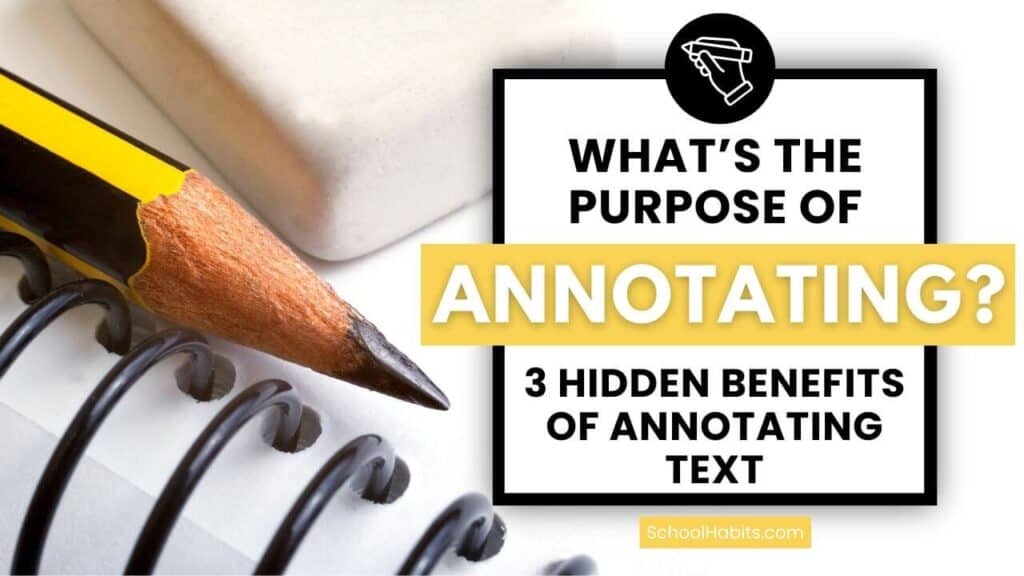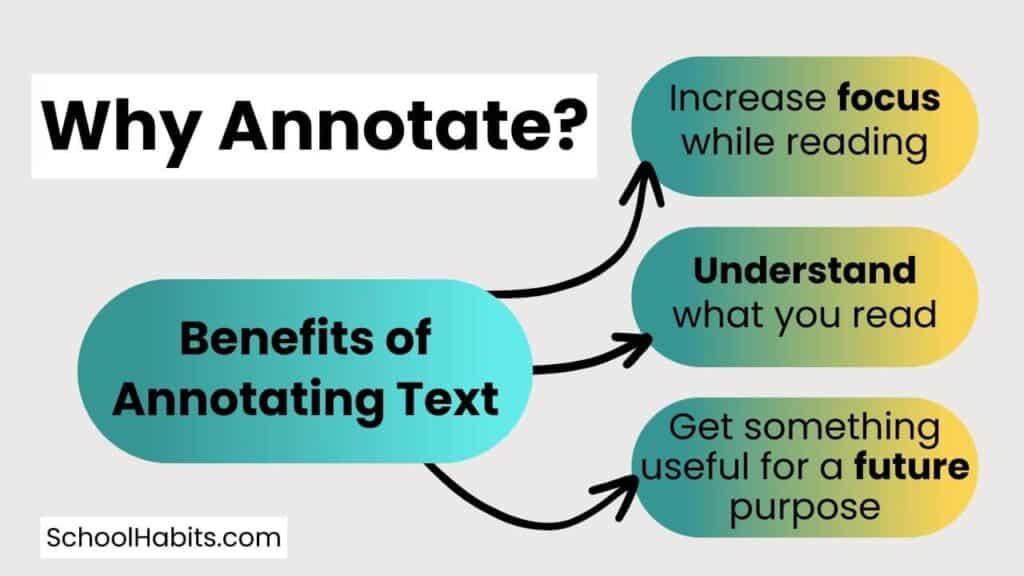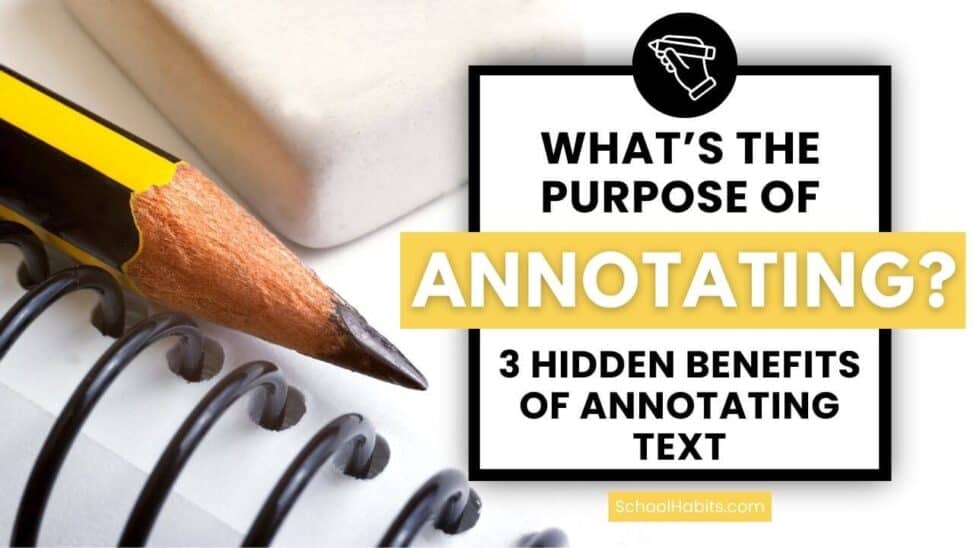
By Katie Azevedo, M.Ed.
What’s the purpose of annotating? I’m asked this a lot because annotating text has a bad rep. Throughout a week, I hear every kind of resistance, from it takes too long, I don’t know what to annotate, I don’t know how to do it, and it’s pointless.
I get it. I really do. If you’ve never been taught how to annotate text correctly, it would feel annoying and forced and slow.
But believe it or not, annotating text serves an actual purpose. (I know! Bananas.) In other words, the whole act of taking notes on what we’re reading has the potential to be useful. And, once you understand how to annotate in a way that’s useful, you’ll find that annotating text becomes so much easier to do.
In this blog post, I’m not teaching you how to annotate. I have so many tutorials and videos that teach annotation skills, such as the following:
- 11 Annotation Techniques
- The Highlight and Rewrite Strategy
- What to Highlight When Reading Novels
- The 6 Most Common Annotation Mistakes You’re Making
Instead of teaching you how to annotate in this post, I am going to answer the question What’s the Purpose of Annotating? In other words, I’m going to give you the top 3 most compelling reasons why annotating text is actually HELPFUL.
My hope is that once you understand the point of annotating, you’ll get to reap the benefits.
What’s the Purpose of Annotating? 3 Hidden Benefits of Annotating Text
Yes, there are benefits to marking up your text as you read it. It’s not just about “looking smart” or “doing it because the teacher said to.”
1. Annotating Increases Focus While Reading
Not everyone struggles with focus while reading, but many people do. If you often zone out while reading, or realize that you’ve read several pages without having any idea what happened, then annotating might be a strategy to try. (You might also want to try these focus strategies.)
Reading involves many parts of the brain, from the vision centers to the language centers, to everything in between. But it doesn’t involve much physical or kinesthetic action. In other words, you don’t move much when you’re sitting down and holding a book.
The more physical something is, the more we can usually sustain our focus as we do it. When we annotate, we add a level of movement and physical action that is just enough to help us concentrate. Think about it: You have to hold the pencil, hold the book a certain way to be able to write in it, and then write in it. This is pretty hard to do and be zoned out at the exact same time.
Even if you never come back to your annotations (you should, which I talk about in #3), they serve a purpose because annotating helps you stay focused on what you’re reading, which increases how much you can understand.
2. Annotating Helps You Understand What You’re Reading
Annotating text helps your reading comprehension. You probably already know this, but reading comprehension is related to the amount of information that you can extract and understand from the text.
Annotating helps your reading comprehension for several reasons. First, when you annotate, you will read slower. This may be annoying at first, but if your goal is to actually understand what you read (how can that not be your goal?), then reading slower is a good thing.
Hey! I know I’m interrupting the flow of this blog post right now, but did you know I have a podcast?! It’s called Learn and Work Smarter, and you can find it on Apple, Spotify, Amazon Music, and wherever you listen to podcasts! I think you’ll love it.
Next, when you take notes on the right things, you are giving your brain the opportunity to think about, process, and rephrase important concepts from the text. If you’re not understanding the text, then you won’t be able to take notes on it, and this is good information that you don’t want to run away from.
If you’re using the highlight and rewrite strategy, which I recommend, part of that strategy involves summarizing chunks of text. Summarizing what you’re reading helps you make sense of it. In fact, if the text doesn’t make sense, then you won’t be able to summarize it.

3. Annotating Lets You Get Something Useful From the Text for a Future Purpose
This is my absolute favorite benefit of annotating text. And I don’t think it’s talked about enough. Let me say this loud and clear: the entire point of annotating is so that you get something useful from the experience
When you annotate text, you should know what it is that you’re looking for, and your annotations should match exactly that.
For example, if you’re reading a science article that you hope to use in your research paper, you should read and annotate for evidence that you’re looking to use in your research paper.
Another example is if you’re annotating a novel that you know you’re going to write an essay on. In that case, your annotations should be about parts of the text that you plan to use in your essay.
A third example is if you’re annotating a history book as you read it, knowing that you’re going to have a test next week. In this case, your goal is to understand the important ideas and vocabulary, so that’s what you should annotate.
If you’re annotating a short story that you’re going to have a test on, or a discussion about, then annotate for comprehension, which means you would summarize short chunks of text as you read. You could also annotate for themes, symbols and events.
If you’re reading a book for pleasure, I suggest you don’t annotate it at all, or maybe just annotate parts that you find inspirational.
If you look at all these examples, I’m giving you, you realize they all have something in common. Every example — from reading, a novel, a research paper, a textbook or a short story — involves annotating in a way that will be useful to you. Every example involves taking notes related to the reason you’re reading the text in the first place.
Final Thoughts about the Purpose of Annotating
Annotating is so much harder to do when you don’t know why you’re doing it. When you’re just highlighting random things, writing down stuff in the margins that you think your teacher will like, or just circling big words you come across, then yes, annotating will seem pointless and difficult.
Therefore, the first step is to get clear on why you’re reading the text to begin with. What do you want to get out of it? What will you be using it for? Get the answers to these questions first, and then you’ll be able to annotate the right things. And that, my friend, is the purpose of annotating.

